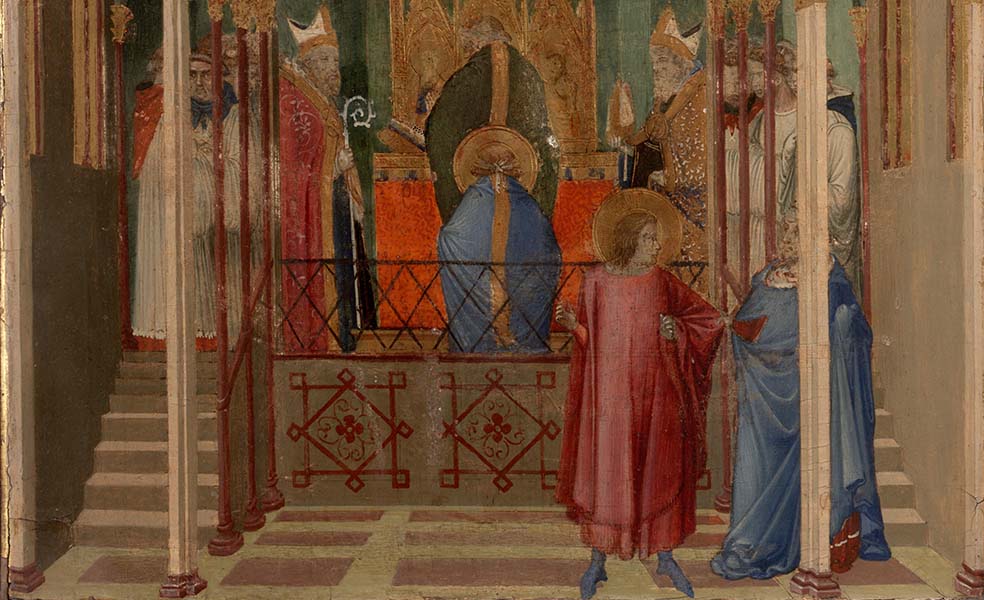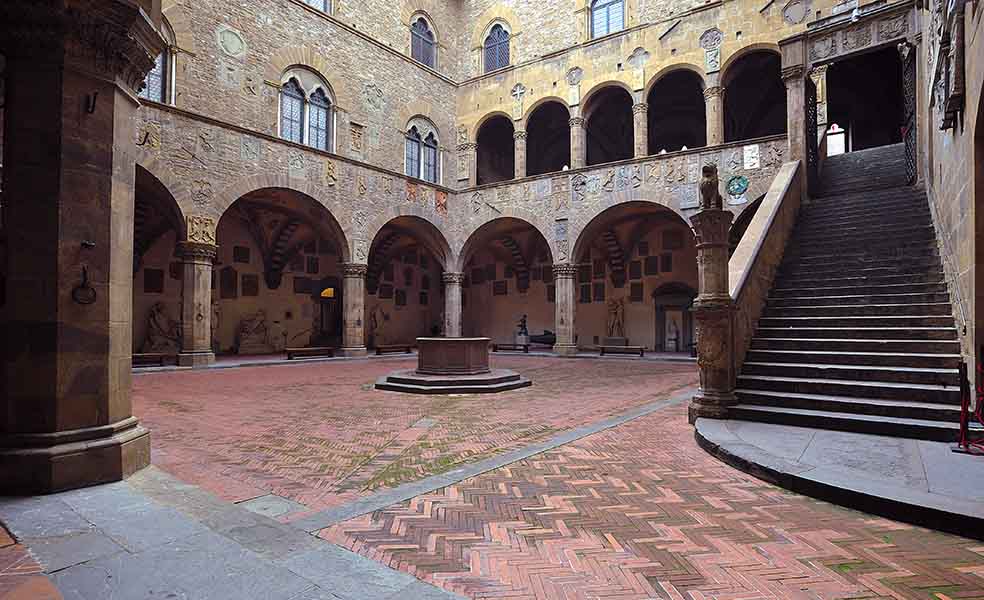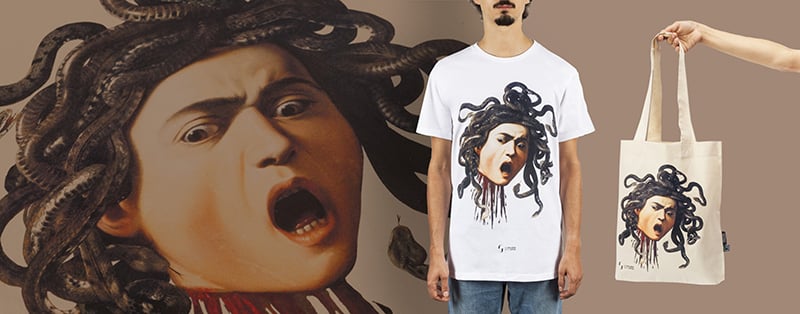Home / Experience / Ambrogio Lorenzetti
Ambrogio Lorenzetti

“Most famous and singular master, he did many works […] he was a most perfect master, a man of great talent: this is Ambrogio Lorenzetti, innovator of languages, styles and Italian iconography” (Lorenzo Ghiberti, Commentarii)
Ambrogio Lorenzetti was undoubtedly one of the main exponents of the Sienese School and Italian Gothic art. Active in the first half of the 14th century, in about thirty years he determined and renewed the Sienese style with his spatial and perspective experiments. Loaded with complex moral meanings, his works invite viewers to undertake a collective reflection on the values of society. This is why Lorenzetti would also be recognised as a master of allegory in painting.
Origins, education and his time in Florence
There is little certain information about his life: he is thought to have been born around 1290 and his presence is documented in Siena and Florence from 1319 to 1348. Today we know that he was the younger brother of the painter Pietro Lorenzetti (c. 1280 – c. 1348), a kinship only discovered in the 19th century, for until then in fact his brother Pietro was known as ‘Pietro Laurati’. Such family origins, in fact, were unknown to both Ghiberti (1378–1455) and Vasari (1511–1574), among the founders of Italian literature and art criticism as well as notable artists.
Like his brother Pietro, Ambrogio initially adopted a language close to Florentine Giottesque culture: his figures are in fact more plastic and monumental, less prone to the Sienese delicacy and sensitivity of Duccio di Buoninsegna (c. 1255–1318) or Simone Martini (1284–1344). His works differ markedly from those of his contemporaries and fellow countrymen due to the particular use of the outline that synthesises the forms and gives more weight and concreteness to the subjects.
After working in the Chianti area (between Siena and Florence), in the early years of the century, Ambrogio was more active in Florence, where in 1327 he enrolled in the Arte dei Medici e Speziali, the guild that regulated the activities of doctors and apothecaries but also of artists, stationers and ceraioli (wax modellers). This was the guild of which other great protagonists of 14th-century culture were members, such as Dante Alighieri (1265–1321), Giotto (c. 1265–1337) and Masaccio (1401–1428).
It was during his time in Florence, thanks to his frequentation of artists and his study of architecture, that his language changed to a more delicate and richly detailed approach, as we can see in the Triptych of St. Proculus now in the Uffizi Gallery (1332). In this panel, in addition to the refined details of the robes and sacred vestments, the humanity of the two protagonists is striking: the Child who – clutching his mother’s finger tightly in an intimate and delicate gesture – observes her curiously; and the Virgin who returns his gaze with a serene and affectionate expression.
The Uffizi also hosts other major works by the artist, such as the four panels with Episodes from the Life of Saint Nicholas (1332) and the Presentation in the Temple (1342).
The alms of St Nicholas; St Nicholas ordained as bishop of Myra, 1330-1335 c. Saint Nicholas resurrects a child, 1330-1335 c.
Siena’s ‘public’ painter
In 1338 he was back in Siena once more, in the famous Sala dei Nove in the Palazzo Pubblico, where he was commissioned to interpret the Allegories of Good and Bad Government and their effects on the city and surrounding countryside. The fresco occupies three of the four walls of the room: the back wall, opposite the windows, and the side walls. Inside the room, visitors find themselves immersed in a very realistic view of life, amid a work some 35 metres long. It was a very difficult work to complete, but Ambrogio managed to do so with great skill. Through the meticulous portrayal of the Sienese countryside and daily life in the city, the artist provides us with direct testimony of the activities and life of the city in the early-14th century. Even today, details of the painting form the basis of historical and social studies on the living conditions and urban activities of Tuscan municipalities. On the two side walls, the work depicts the effects that good – or bad – government has on a city. This is among the most famous examples in the history of Italian art of paintings in which political and philosophical ideas are merged with religious content. In the Allegories of Good and Bad Government, Ambrose makes use of rich symbolism and personifications of values to convey eloquent secular messages and ideologies. This intention is also made explicit in the context that hosts the work: the Sala dei Nove was, in fact, the seat of meetings of the Sienese government and the paintings serve the purposes of both teaching and warning.
His Last Years and Death
After the success of the Allegories of Government, Ambrogio Lorenzetti remained in the city to pursue various assignments, including the aforementioned Presentation of Jesus at the Temple (1342), painted for the altar of San Crescenzio in Siena Cathedral and now in the Uffizi Gallery.
Rightly considered one of the artist’s greatest works, here his spatial and perspective experimentation is at its finest: the complex architectural setting, representing the interior of a church, is mainly played out on the perspective lines of the refined floor. The elegant altarpiece is steeped in precious details and the contact with Giotto’s artists can also be traced by the use of chiaroscuro in the bodies of the protagonists, illuminated by an imaginary point of light. The naturalistic innovations typical of the artist are remarkable: here, too, the Child moves his feet and sucks a finger, as if to emphasise his genuinely human aspect.
The brilliant future that the artist had ahead of him was cut short in 1348 by the advent of the Black Death: like his brother Pietro and many other artists of the time, Ambrogio Lorenzetti died after being infected by the plague that was decimating the European population. Shortly afterwards, according to documents that have been handed down, his wife and three children also met the same fate.
Presentation in the temple, 1342Cover photo: Stories of Saint Nicholas, circa 1332, Ambrogio Lorenzetti, Uffizi Gallery, Florence
Gallery
«Famosissimo et singularissimo maestro»: Ambrogio Lorenzetti painter and innovator of Italian stylistic languages and iconography (Lorenzo Ghiberti, Commentarii)
Related products
No products were found matching your selection.





